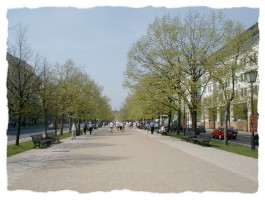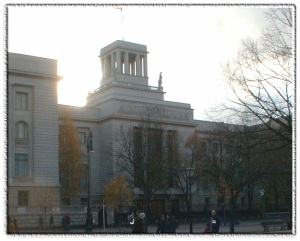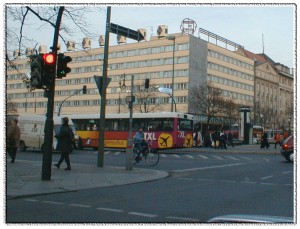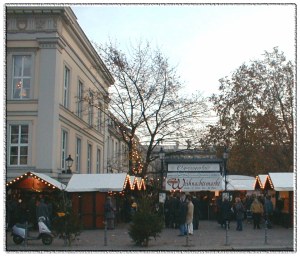












60m wide and circa 1,4km long is the famous street 'Unter den Linden', which runs from Pariser Platz to the Lustgarten. In 1573 an electoral bridle path ran along this route through the Markish sand all the way to the hunting ground. The Great Elector Frederick William had 6 rows of nut trees planted along the way by his court gardener Hanff and through the architects Dressler and Grünberg, only to be removed in 1675, due to the fixing of the way. Residences, farm buildings, public official buildings and a palace were the first buildings. After 1674 the north side developed into the most important city district, named Dortheenstadt after an Elector Dorothea's Barbican. From 1688 to1692 Friedrichstadt was created at the south-side after plans by J.J. Behrs. Beginning of the 18th century, Frederick the Great had palatial buildings constructed along the road. But the first building, the Zeughaus (armoury, today historical museum) was already there. A little later, the Gendarmenmarkt was created in the south. The street ran until 1743, only to the Schadow-Straße and was then extended to the Pariser Platz. Frederick II commissioned Georg Wenzeslaus von Knobelsdorff to find and create a representative magistral form as a cultural centre in the city, but only the opera, today's German State Opera was completed because he fell out of favour with Frederick II. 1747-1773 the Sankt-Hedwigs-Cathedral was constructed. The constructing of the old library was performed by Georg Christian Unger. 1789-1791 the road got its architectonic finish through the building of the Brandenburg Gates. 1816-1818 the Neue Wache was built by Karl-Friedrich Schinkel. Only in 1946 were young lime trees planted again.

When one starts the walk at the Brandenburg Gate, one sees on the right side predominately contemporary administration buildings. On the right the Russian emabssy, the former residence of the Russian ambassy. The junction "Unter den Linden/Friedrichstraße" was, before the 2nd World War, one of Berlin's most popular places. After its destruction the 'Linden-Corso', a public house has been there at the southeast corner since 1965. At the northeast corner is now the hotel 'Unter den Linden', opposite the Haus der Schweiz and at the south-side opened the Grand Hotel in 1987. Via the Charlottenstraße one walks past the State Library. On the road's central strip stands the equestrian statue of Frederick the Great, which was created by Christian Daniel Rauch in 1851. It depicts the king sitting on his favourite horse 'Conde' with kings' coat, three-cornered hat and bucket top boots. On four tablets in the lower section are the king's 60 most important contemporaries immortalised. In the middle section are life-size generals, men from politics, art and science as well as rider figures of the Prince Heinrich of Prussia, Duke Ferdinand von Braunschweig and the generals Friedrich Wilhelm von Seydlitz and Hans Joachim von Ziethen depicted. Flat reliefs decorate the upper section with scenes of Frederick's life as well as allegoric figures.

After the state library follows the building of the Humboldt-University with the marble statues of the brothers Alexander and Wilhelm von Humboldt in front of the entrance portal and with rare ginkgo-trees in the front garden. On the other side of the street is the Bebelplatz (Opernplatz) situated with the German State Opera and at the southeast corner the Sankt-Hedwigs-Cathedral. At the westside of the place we find the building of the Old Library, which originated after plans by Fischer von Erlach in the years 1775-1780 as royal library. Because of its curved baroque facade often described as 'chest of drawers'. The rebuilt Old Palace is joined directly and belongs today to theHumboldt-University. William I lived here for 50 years till his death in the year 1888.

Next to the Old Palace stands, today the New Gouverneur's House with facade embellishment that stems from the old commandant's house at the Rathausstraße. Opera Cafe and crown prince palace, follow and in a small park one can admire statues of generals Blücher, Gneisenau, Scharnhorst and Yorck, which were created by the sculptor Christian Daniel Rauch. Further on in the direction of Alexanderplatz on the left roadside is the Neue Wache located. The end of the left roadside is formed by the Zeughaus (armoury), today, German Historic Museum. via the Plalace Bridge one reaches the Lustgarten and the cathedral.
Transport Links
S-Bahn: S1, S2, S25 (from station Friedrichstraße)
Bus: 100 (from station Zoo, from station Alexanderplatz)